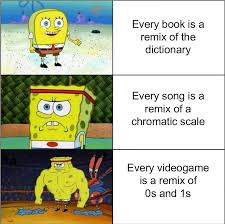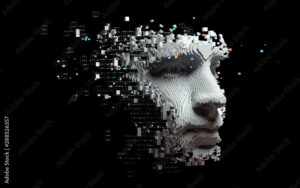As educators, we continuously adapt, merge, and borrow ideas to craft meaningful educational experiences. Yet, despite teaching being inherently collaborative and adaptive, there’s often a lingering stigma around the idea of “copying.” This stigma raises critical questions about originality, creativity, and professional integrity in education. Perhaps it’s time we reconsidered what it truly means to “copy” in our classrooms.

copyright: cm3positive (instagram)
Teachers are natural remixers. We draw from diverse frameworks, strategies, and culturally responsive methods to create dynamic curricula. In fact, we are taught from day one in school that anything new we teach to a student should be scaffolded from previous knowledge that already exists in our mind. From integrating Indigenous knowledge systems and interdisciplinary units to leveraging digital tools and frameworks like Universal Design for Learning (UDL), we constantly adapt and merge existing resources into new, context-specific learning experiences. This process isn’t about copying—it’s about thoughtful adaptation. I took a look at a research paper done by Stephanie J. Loomis at Georgia State University, and what she found was that “remix allowed teachers to increase the student-centeredness of their pedagogy and at the same time support multiple student learning styles.” ( Loomis, Stephanie J. ) For me personally, when I am at my most creative in my life, whether it be creating posters, painting, or dancing, I usually draw from a previous picture, dance, or image I saw and remix it in my way to make something semi-new (as stated in the video ” Everything is a Remix” this concept is what our human nature is programmed to do.
“Artificial intelligence is only as good as the data it learns from.” (graciousquotes.com)

copyright: reddit- r/memes
However, the educational landscape often pushes teachers towards originality as proof of effectiveness. The result? An unnecessary and unrealistic pressure to continuously reinvent rather than collaboratively refine. But education thrives on sharing. Open Educational Resources (OER) movements like teachers pay teachers, professional learning communities, and online educator networks prove that effective teaching comes from openly borrowing and thoughtfully remixing best practices. I was always told in my career, why reinvent the wheel if there is already something out there you can take and make your own, or make work better for your needs. I do believe however, it is ALWAYS important to give credit where credit is due.
Enter artificial intelligence (AI). The rapid emergence of AI tools like ChatGPT, DALL·E, and adaptive learning platforms has profoundly impacted our understanding of remix culture both within and beyond education. AI tools can instantly generate, remix, and personalize educational content, blurring the traditional lines of authorship and originality. This shift invites educators and students alike to rethink what creativity and innovation mean in an AI-driven world. Recently I have spoken with a few different employers about their thoughts on AI and its use in the workplace, and one of them looked me in the eye and said, I would not hire someone who did not know how to use AI, why you ask? It can make an already good employee who has a good work ethic and ideas an even better more efficient worker by taking the monotonous aspects of their job and finishing them in a fraction of the time. This leaves them to do the critical part of their job, like critical thinking and coming up with ideas etc.
“Artificial intelligence is not a substitute for human intelligence; it is a tool to amplify human creativity and ingenuity.” Fei-Fei Li
In the classroom, AI provides powerful opportunities to customize curricula, assessments, and instructional strategies at unprecedented speeds and scales. Students, too, become active remixers—using AI-generated content as raw material for their own critical, creative, and collaborative projects. Outside education, AI-generated art, music, and media challenge society’s broader assumptions about creativity, authorship, and ownership.
This AI-driven remix revolution forces us to reconsider our stigmas around copying. Is creativity solely about being first or original? Or is it increasingly about how effectively we adapt, synthesize, and apply ideas to add meaningful value? Perhaps originality in education should be redefined less as the invention of entirely new ideas and more as the skillful integration, adaptation, and remixing of existing ones.
As educators, our goal shouldn’t be to resist these shifts, but rather embrace them thoughtfully. By openly discussing ethical boundaries, fostering responsible use of AI, and nurturing a culture that values creative adaptation, we can evolve education into a vibrant ecosystem of collaborative remixing.
Ultimately, the future of teaching might lie not in how much we create from scratch, but how skillfully we can adapt, borrow, and remix—with a little help from AI along the way.
What do you think? I want to swing back around to the question above, Is creativity solely about being first or original? Or is it how effectively we adapt, synthesize, and apply ideas to add meaningful value? Leave me a comment below, and tell me your thoughts!
References:
Loomis, S. J. (2019). Remixing pedagogy: How teachers experience remix as a tool for teaching English language arts (Publication No. 14424628) [Doctoral dissertation, Georgia State University]. Georgia State University Digital Archive. https://doi.org/10.57709/14424628



Shasta, I agree that many open educational resources are based on the adaptation of existing materials. Most teachers copy ideas from textbooks and remix them with ideas from other sources to better suit their classroom context. I have seen a lot of students and teachers who have been so creative in the tasks they use in class, but this does not necessarily relate to the original piece. I have come across content where the remixed version is more valuable and meaningful compared to the original version. In my opinion, I think creativity is not about originality but about relating ideas in such a way that they become valuable and impact the society or context in which they are being used.
Thanks for the insight! My question is, can creativity be both of those things? Both original and relatable/valuable/ and make an impact on society? I am not sure there is a right or wrong answer here. I feel as though both those features can be considered creative. Something to think about anyway. I appreciate you allowing for this conversation about it!